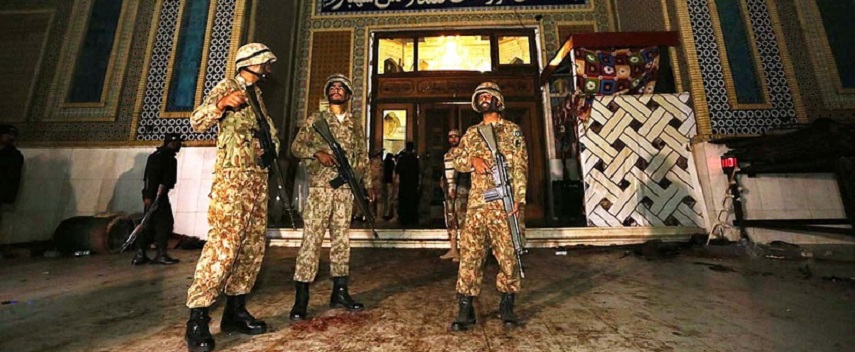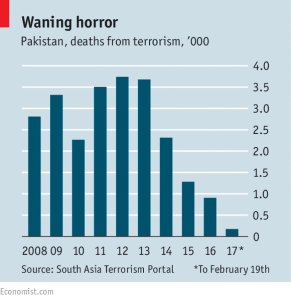In the space of five days in mid-February, Pakistan suffered ten acts of terrorism, affecting all four of its provinces. On February 13th a suicide bomber killed 15 people outside the provincial assembly in Punjab, including two senior police officers. On February 16th more than 80 were killed and over 200 injured when another suicide bomber targeted the throngs of worshippers at Lal Shahbaz Qalandar, a Sufi shrine in the southern province of Sindh. Yet more bombs killed police and soldiers in Balochistan, Khyber Pakhtunkhwa and the Federally Administered Tribal Areas (FATA), along the border with Afghanistan.
The attacks are all the more shocking because deaths from terrorism in Pakistan have fallen dramatically in recent years (see chart), the result of a sustained counter-terrorism campaign by the security services. Swathes of territory once lost to militants have been recovered. Operation Zarb-e-Azb, launched in 2014 to retake North Waziristan, a part of FATA that had become a jihadist stronghold, was a turning point. Until then, fretful politicians had postponed confrontation with the Tehreek-e-Taliban Pakistan (TTP), the Pakistani offshoot of the militant Muslim group that ruled Afghanistan until the American invasion of 2001 and threatens its government to this day.
It was a faction of the TTP that claimed responsibility for the attack on the Punjab assembly. Islamic State, the extremist group that controls parts of Iraq and Syria, said it was responsible for the bombing of the Qalandar shrine, although it is likely to have worked through a local group. But Pakistan’s army identified a third culprit: Afghanistan. It said the Afghan government was not doing enough to stamp out militant groups, and that the militants, in turn, were using Afghanistan as a base to plan attacks in Pakistan. It closed all border crossings and shelled what it said were militant camps on the Afghan side of the border. The army also demanded the immediate arrest of 76 terrorists it said were living in Afghanistan.
It is true that Islamic State, the TTP and many other groups have bases inside Afghanistan. Afghan spooks may well provide them some assistance (in 2013 American special forces caught a leader of the TTP on his way to Kabul for secret talks). But the beleaguered government in Kabul, which has lost much of its territory to the Taliban insurgency, is in no position to satisfy Pakistan’s demand that it detain particular militants. They are based in areas where its writ is minimal or non-existent.
Moreover, the Afghan government is beleaguered in part because the Afghan Taliban has itself long enjoyed sanctuary on Pakistan’s side of the border. This week the Afghan government announced that its forces had killed Qari Saifullah Akhtar, a Taliban leader repeatedly captured and released by Pakistan. With many more of the Taliban’s leaders, bomb-makers and indoctrinators beyond the reach of Afghan troops and their allies in NATO, it has proved impossible to defeat the 16-year insurgency. Yet Pakistan has shielded the Taliban because it sees the group as its only ally in Afghanistan, a country it fears is too cosy with India, its arch-rival.
While the army harasses Afghanistan, there is much that Pakistan could do to fight terrorism domestically. A National Action Plan drawn up in the wake of the massacre of more than 130 schoolboys by the TTP in Khyber Pakhtunkhwa in 2014 has not been fully implemented. Regulation and reform of madrassas, religious schools that foster militancy, has been half-hearted. Notorious peddlers of sectarianism remain at large. It does not help that the army wants an even bigger role in domestic security—a source of tension with the civilian authorities. There is nothing Afghanistan can do about all that.
This article originally appeared in The Economist, February 23, 2017. Original link.
Disclaimer: Views expressed in the article are not necessarily supported by CRSS.


